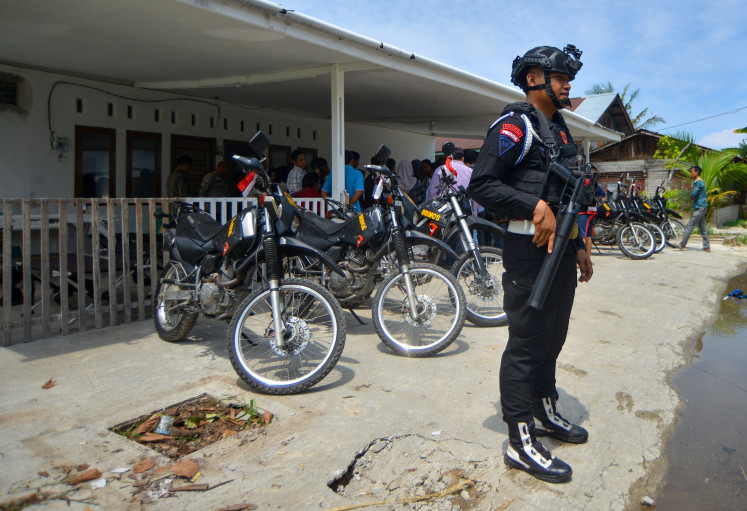Popular Reads
Top Results
Can't find what you're looking for?
View all search resultsPopular Reads
Top Results
Can't find what you're looking for?
View all search resultsSensual, somber Drupadi marks F. Widayanto's 30 years in art
Drama Republic
Change text size
Gift Premium Articles
to Anyone
Drama Republic.
Ceramics artist F. Widayanto is celebrating his three decades of work with an exhibition featuring Drupadi, one of the most prominent heroines in the epic Mahabharata.
'Drupadi represents a character who does not hesitate to go all out, fully committing herself in her life; I can relate to her,' said Widayanto, who is also known as Yanto to his friends.
The exhibition titled 'Drupadi Pandawa Diva,' which opened on Thursday and will last until Aug. 30 at the National Gallery in Central Jakarta, features a total of 30 Drupadi statues.
Yanto, who turned 60 in January, began working on Drupadi immediately after he completed the 'Semarak 30 Semar' exhibition in 2009.
'Drupadi took around two-and-a-half years to complete. The statues were all finished about a year ago and then I began preparing for the exhibition,' he told The Jakarta Post recently.
Dru vs. Dur
In the Mahabharata, Drupadi and her sibling, Dhrishtadyumna, are born out of a fire sacrifice performed by fallen King Drupada of Panchala. She is described as a flawlessly beautiful dark-skinned woman blessed with youth and intelligence, emitting the aroma of lotus blossom.
Drupadi was married to the Pandava brothers ' Yudhistira, Bhima, Arjuna, Nakula dan Sadeva ' after Arjuna won her hand through a contest. The brothers were rulers of the Indraprastha Kingdom
Pius Firman, in his introduction to Yanto's exhibition, wrote that the story differed slightly in the traditional Javanese wayang shadow puppet play, which was performed according to Islamic teachings after the fall of the Hindu kingdom of Majapahit. In the wayang version, Drupadi was only married to Yudhistira.
Yudhistira, an otherwise model of virtue, has one weakness: gambling. He could not resist a challenge from Suyudana, a state guardian of the rival Astina Kingdom, to play a game of dice with all their possessions at stake. The game was in fact a ploy by Suyudana to take over the brothers' kingdom.
Yudhistira eventually loses and with his gambling debt, offers Suyudana his throne, his kingdom and also his wife, Drupadi. Drupadi is duly asked to appear before the party but she refuses. Suyudana then orders his brother, Dursasana, to fetch her.
Dursasana grabs the resisting Drupadi by her long hair. The angry Dursasana later pulls Drupadi's sari, disrobing her in public. Drupadi prays to Kresna for rescue. Miraculously, the sari begins to stretch endlessly, defeating Dursasana's effort to render her naked. Eventually, Dursasana gives up and Drupadi retains her honor.
The incident is often considered to be a definitive moment and one of the main causes of the Bharatayuda war.
Drupadi vowed not to tie her hair until she had decorated it with the blood of Dursasana. She fulfilled her vow when Bima later defeated Dursasana in the great war and presented his rival's blood to her.
Yanto said that in the Drupadi series, he focused on the event of Drupadi's attempted disrobing by her rival.
'I also used the elements of lotus and dice because they cling close to Drupadi,' he said,
Always underlining his Javanese roots, Yanto has portrayed Drupadi not wearing a sari ' the Indian strip of unstitched cloth that is draped over the body ' but instead the traditional Javanese kebaya.
'With my Drupadi, instead of being stripped of her sari, she is stripped of her stagen [waist sash]. In some of the statue names, I mistakenly referred to the sash as kemben [breast cloth]; it was actually the stagen,' Yanto explained.
The artist said he wanted to showcase his technical achievement with the exhibition.
'These are by far the largest statues that I've exhibited. Some reach two meters high, while others extend 2.5 meters in length,' he said.
Due to limited capacity inside his kiln, Yanto was forced to cut his sculptures into pieces before firing them.
'There's a very big risk of deconstructing the sculpture because the pottery can break and contract after firing. Reassembling them is also hard work, because you try to hide the fact that they were taken apart,' he said.
Drupadi also displays intricate details and lively structures represented by the flowing stagen and hair.
Kemben Ngeler.
He has also incorporated other material into the Drupadi statues: wood, metal, stones and cloth, including accessories and jewelry designed by Alston Stephanus.
Yanto got involved in all the stages of ceramic making, from mixing the clay, forming and sculpting and firing and glazing, which included mixing the color palette for the glazes.
'This long, tedious process is what made me respect the clay. A single mistake in the process and you have to start all over again because biscuit cannot be turned into clay again.
'It's a lesson in life. You make a mistake and you have to start from scratch, but you don't quit,' he said.
Looking back on his career, Yanto said he had everything he had ever wanted and he had no other target besides keeping on working and staying healthy.
'When I decided to major in ceramics after high school, I had no support from anyone. Even my father questioned me.
'But I had faith in what I was doing and now, I have galleries and display houses in Jakarta and a workshop in Tapos, West Java. I also have 85 people in my staff,' he said.
Yanto said he would continue working for himself and for the sake of those around him.
'I will do this until I die. We must never stop. It is only by moving that we know we are well,' he said.
' Photos courtesy of F. Widayanto












